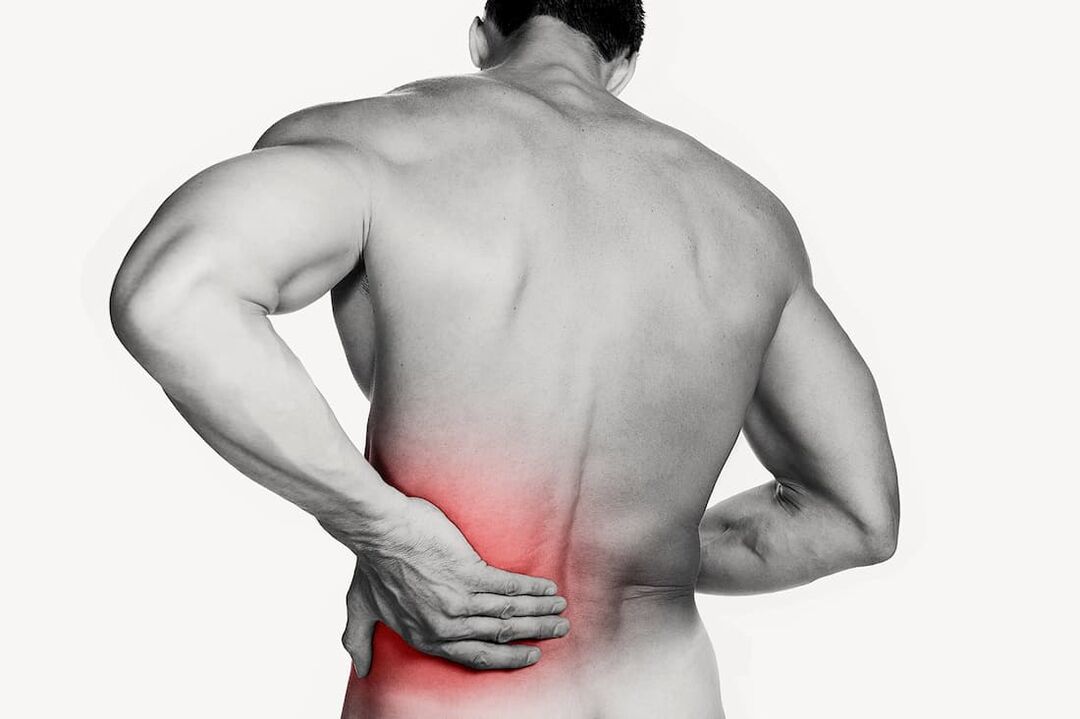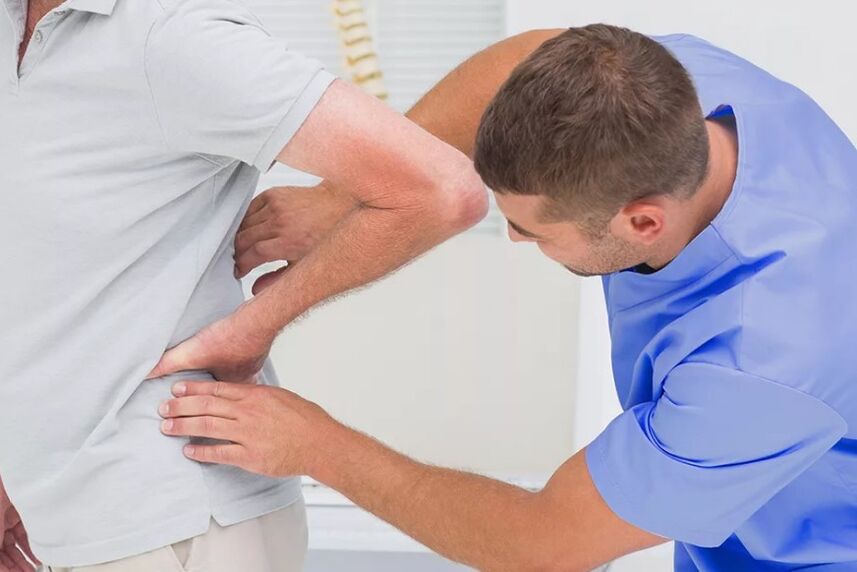
Low pain is a rare symptom.Most people associate it with work in sitting, weight lifting or osteochondrosis and not in a hurry to see a doctor.In fact, this condition can indicate kidney, liver or intestinal disease, and problems with the musculoskeletal system will not be experienced.Only timely examination of experts and full examinations will help identify the cause of the pain and choose the right treatment.
General information
The lower back is an area that has a significant load as it is in a upright position.The spinal column is represented by five large vertebrae, which is also reinforced by muscle frames.9 out of 10 cases of pain in this area are properly provoked by the pathology of the musculoskeletal system: osteochondrosis, muscle cramps, intervertebral disc hernia, pinching nerve roots.
The remaining 10% of cases are associated with internal organ disease located in the lower back projection: kidneys, genitourinary system, intestines, liver.Even a doctor, when examining, cannot always determine the cause of the pain, which is why this condition requires a comprehensive laboratory and instrumental diagnosis.
Type of pain
The first thing a doctor asks is the nature of the sensation.Depending on the cause of it, the lower back pain may be:
- Acute: usually arises significantly, characterized by high intensity;The sensation period is not more than 1.5 months;
- Subacute: 6-12 weeks;
- Chronic: Sensation of any intensity that lasts for 12 weeks or more;
- Transfer (variable): appear periodically;
- ill;
- stupid;
- Strong, average intensity, weak.
This section is conditional.Depending on the circumstances and circumstances, the nature and duration of the sensation may vary.It is important to describe them as soon as possible.
Cause
The reason why the back starts to hurt the bottom.Often, provoking Serving Factors:
- hypothermia;
- heavy lifting;
- uneven distribution of loads (against pregnancy background, posture disorders, musculoskeletal system pathology);
- Infectious wounds;
- disease of the musculoskeletal system;
- inflammation processes, including autoimmune;
- Long staying in an uncomfortable position;
- changes in bone tissue composition (osteoporosis);
- Volumetric processes: benign and malignant tumors, abscess;
- hormone changes (menstruation, pregnancy, menopause);
- kidney disease (urolithiasis, pyelonephritis, glomerulonephritis, abscess);
- gastrointestinal tract pathology;
- Uterine and complementary disease in women, prostate in men, etc.
Disease
Low pain can be a symptom of various diseases of the musculoskeletal system and internal organs.The main task of the doctor is to find out what actually causes the deterioration and take the necessary steps.
Here is the most common pathology.
Ankylosing spondylitis
This is a systemic inflammatory disease, in which individual vertebrae in one conglomerate occurs.At the same time, calcium deposits in the ligaments that stabilize the spine occur, resulting in the affected area nearly loss of mobility.
The distinctive features of back pain with ankylosing spondylitis include:
- increased intensity at rest, especially with prolonged discoveries in horizontal positions;
- Movement constraints in the lumbar region;
Lumbar spinal osteochondrosis
This is a very common disease, where the disc is thinner, performing the role of shock absorber.As a result, the nervous root and muscle cramps around which cause severe pain to feel irritated.In the final stages of the disease, intervertebral disc hernia is formed, which can suppress the spinal cord, increase pain.
With osteochondrosis, the pain is increasing:
- when lifting from an inactive or horizontal position;
- When trying to lie on the stomach;
- With a tendency.
If the disease causes the formation of large hernia -anxiety, pain in the lower back is often accompanied by numbness and either weakness of one or both feet.
Spinal curvature in the lumbar region (kyphosis, scoliosis)
Pain in this pathology occurs in the middle and end stages of the development of the disease.Discomfort usually occurs at the end of the day and is often accompanied by the fatigue of the spinal muscles.Pain is more often caused by spinal cord cramps, and is also possible to explore the muscles in the removal (gluteal, periosemantal muscles at the upper and lower part).
Spondylarthrosis
This is a degenerative-dystrophic disease of cartilage, which covers the intervertebral disc.It is gradually thin and destroyed, bone growth (osteophytes) appears around the lesion area.As a result of the reduction in the distance between the vertebrae, the narrow spinal canal, the nerve root and the spinal cord are impressed.
Ill with this pathology:
- strengthen after the load (stay long in standing, walking) and passes after a break;
- accompanied by movement stiffness, first in the morning, then remain;
- It can be given to thighs and hip joint areas.
The muscles in the lesions are spasmodic and always tension, which also increases pain.
Urolin disease
Urolithiasis attacks are characterized by severe lumbar pain from the affected kidneys.At the same time, the sensation does not change depending on the pose, one cannot find a position where they are at least weak.These attacks are often accompanied by a reduction in urine volume and color change to redness.
Low pain can also be the result of:
- algomenor (painful menstruation);
- pregnancy;
- pancreatic inflammation;
- osteomyelitis;
- intestinal obstruction;
- appendicitis, etc.
Pain in various backs
The localization of pain can say a lot about their reasons.The pain in the upper lumbar area may be the result of:
- spinal disease;
- injury;
- muscle cramps against their overvoltage background;
- cardiovascular disease;
- tumors;
- Gastrointestinal tract disease.
If the quake center is located on the lower back, a list of possible causes included, in addition to spinal disease:
- kidney pathology (pyelonephritis, urolithiasis);
- Intestinal disorders (constipation, bloating);
- cramps or inflammation in the pelvic organs (salpingoophorite, endometritis);
- physiological causes, in particular, pregnancy;
- Pinch the sciatic nerve.
The displacement of the pain on the right or left may indicate a spinal cord that corresponds to the spinal cord, the kidneys.
Diagnostics
The diagnosis of lower back pain requires a comprehensive examination.The first stage finds the reason for the survey.The doctor explains:
- Localization of pain;
- character and duration;
- causes that cause attack or increase pain;
- Conditions in which the situation improves (certain pose, immobility, drug taking, etc.).
Data on injuries and illnesses, have been identified by chronic pathology collected without fail.Further diagnostic search at the doctor's discretion includes:
- General tests of blood and urine: help identify the process of inflammation in the body, kidney pathology;
- Biochemical blood tests to identify signs of kidney damage, pancreas, liver and gall bladder, and so on;
- Ultrasound of the abdominal organs and pelvis, in men - ultrasound of the prostate gland;
- Kidney ultrasound;
- Radiography, CT or lumbar spine MRI;
- X -Ray chest.
In the event of any pathology after diagnosis and review examination, more targeted tests, narrow expert examinations and consultations are prescribed.They allow you to explain or deny the diagnosis.

Treatment
The treatment of pain in the lower back depends on the cause.Neurologists, urologists, gynecologists, and surgeons can be involved in pathology.When we talk about the disease of the musculoskeletal system, doctors use medical methods, not drugs and surgery to improve the patient's condition.
Drug
The most common way to eliminate lumbar pain is non -ssteroid (NSAIDs) anti -inflammation.They are prescribed in the form of tablets, intravenous and intramuscular injections, rectal suppositories, as well as creams, ointments and plaster for local use.The results of the product dosage, as well as the duration of the course, are made by the doctor, as the use of these drugs is uncontrollable can cause unpleasant side effects.
If the NSAID is ineffective, the doctor prescribes hormone (corticosteroids).They also stop the inflammation process and help reduce pain.
The third group of drugs that improve the patient's condition is antispasmodic.They remove muscle cramps at the bottom.
In addition, they can be appointed:
- decongestants to reduce the edema of the pinched root;
- B vitamins to improve nerve flow;
- Sedative.
Non -Drug methods
Non -Drug treatment completes a medical scheme.Depending on the clinical situation, it may include:
- Physiotherapy procedures (magnetotherapy, laser effects, electrophoresis, and others);
- Physiotherapy Exercise: Training courses are developed individually according to the main and related illnesses;Gymnastics should be done regularly, not only in the clinic office, but also at home, only in this case it has an effect;
- general reinforcement and therapeutic massage (performed outside the exacerbations);
- acupuncture;
- Therapy and manual help to osteopath.
Surgical
The help of the surgeon is necessary if the attending physician based on the general picture reveals one of the indications for surgical treatment.The presence of intervertebral disc hernia is not a guide for surgical treatment, regardless of size.Depending on the signs, the doctor can remove the intervertebral disc hernia, eliminate the compression of the spinal cord, remove the tumor, and more.The decision to carry out certain operations is made individually.
Prevention
The most effective way to prevent back pain is to adjust your lifestyle to release the kidneys, spine, and pelvic organs, but if pain often arises, this should be an excuse for an unusual appeal to a specialist:
- Avoid hypothermia;
- prevent hypodynamia;
- Play sports at the amateur level (swimming is very useful affecting the spine and back muscles);
- Correct and balanced to eat: prevent excessive eating, minimize fat, spicy, too salty foods;
- excluding alcohol and nicotine;
- Drink at least 1.5 liters of pure water daily without regard to tea, coffee or juice;
- Make sure the body mass index is at a normal level: excess weight does not affect the spinal cord, and deficiency can cause kidney honors.
If a person has diagnosing the pathology of the musculoskeletal system, it is advisable to at least twice a year, according to European proposal for the recovery of spinal pathology, to undergo a preventive course according to the appointment of a doctor.






















